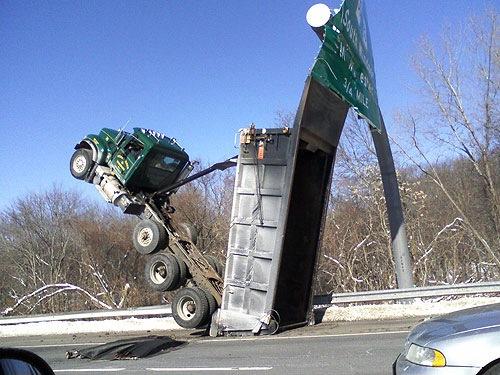A brief story about how to google intelligently. With a topping of design and a truck crash.
A colleague that I greatly respect and admire recently used the image below in a lecture, as an example to discuss sources of accidents.
 Someone asked if my colleague knew what actually happened. He responded that he didn’t know and that he couldn’t even remember where he’d found the image.
Someone asked if my colleague knew what actually happened. He responded that he didn’t know and that he couldn’t even remember where he’d found the image.
Well…. CHALLENGE ACCEPTED!
First, I tried a Google Image search for: truck caught on highway sign. There were many similar pictures – frighteningly many, in fact – but that particular one wasn’t listed.
Then I tried: truck hits highway sign. And there it was, on the second screen’s worth of images.
I clicked on the image. That took me to http://pragmatos.net/2009/03/05/for-obvious-reasons-thats-wrong/, which linked to http://www.courant.com/news/local/hc-truckrescue0305.artmar05,0,731492.story, at the Hartford Courant (local newspaper) website. But that story no longer existed.
So then I copied the Courant URL and went to https://archive.org/, the so-called Internet Archive, an organization that has as its goal to document every web page ever – even the ones that have been deleted. Currently, it archives over 445 billion web pages. Sure enough, I asked it to search for the missing Courant URL and it found several copies. I selected one of the earliest, and while it doesn’t have the image, it does have the rest of the article.
So between the Courant article in the Internet Archive and the image from the pragmatos website, I could reconstruct the entire story – at least insofar as it was originally reported.
Total search time: 5 minutes, at the most. Thanks Google!
In case you’re wondering about my own interpretation of what happened to the truck, here’s what I think.
Let’s start with three details of the photo that you may have missed.
First, look at the highway sign. Some highway signs span all lanes of a roadway (like most of the ones on Highways 400 and 401 in Toronto). But this sign is different; it clearly doesn’t span the roadway – you can see the end-cap! So this sign came up from the side of the road and stretched out over only part of it.
Second, look at the lane markings painted on the road. I see a typical dashed line in the foreground, very near the bottom of the photo. But the line painted just by where the truck is is solid. It looks like the truck is on the shoulder of the road. Additionally, the traffic lane to the immediate left of the truck appears to be narrowing from right to left; that is, it appears that lane is the merge lane onto the highway from some other street.
Thirdly, using the lane markings painted on the road as a visualization guide for depth, try to imagine how far out into traffic the green sign actually extends. Look at the sign’s end cap and imagine a vertical “plumb” line dropping down to the road; where would that line hit pavement? It looks to me like the sign extends over but not past the merge lane.
This jibes well with what is reported in the story – that the driver had just dropped off his truck’s load at a construction site, and was getting back on the highway (probably from a temporary construction entrance off the shoulder of the actual highway). Had the truck managed to merge (right) into traffic a little bit faster, it could well have missed the sign. Of course, that just opens the possibility of another, more serious accident – the truck is still in the raised position, remember – when the rig was going faster. But it also opens the possibility of affording the driver more time to notice the truck was raised and to get it lowered before a more serious accident could happen….
Is it the driver’s “fault” that this accident happened? Not even the newspaper story tells us enough to be sure. And in any case, design isn’t so much about “fault” (which inherently about the past) but rather about “opportunity” (which is about the future). We can’t undo the accident that has already happened. But we can act to help ensure that this kind of accident doesn’t happen again. What can we do to prevent future occurrences? To answer this question, it is important to understand “cause,” but that’s entirely different from “fault.”
(Exercise for the reader: Why are “cause” and “fault” inherently and very significantly different?)
Consider this analogy to my car. I drive a 2015 VW Beetle*. It has an unfortunately many automated gadgets and gizmos. If I switch the radio to “media” it immediately tells my phone to start playing music. The wipers adjust speed from fully off to high speed based on some kind of rain-meter. The headlights decide whether they need to be on or off based on ambient conditions. At night, the inside rear view mirror dims automatically to prevent headlight glare of the cars behind me from blinding me. All kinds of systems turn on and off automatically when I lock and unlock the car. When I start driving, the doors lock themselves; when I put the car in park, the doors unlock themselves.
It’s really quite decadent.
If we can do all that for a not-especially-expensive car out of little more than a desire to convenience the driver (because – let’s face it – all these automagical systems are only about convenience), why can’t we come up with ways to convenience the truck driver?
Exercise to the reader: How many ways can you think of to help the truck driver not wander off with his truck raised?
* They say it’s painted “Tornado Red” but I just have no idea what that means as I’ve never seen a red tornado. Bloodnado, perhaps?
